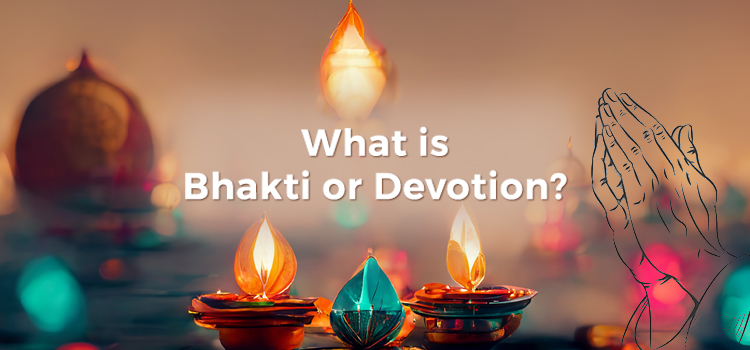What is Bhakti?
Bhakti, as we use it commonly, means faith or devotion.
The Sanskrit word, Bhakti, in Hinduism, comes from the word ‘bhaj’, which means “go to oneself to” or “have recourse to”, “to pray”, or “to worship “. It can also mean fondness, attachment, love, religiosity, piety, spirituality, etc. For instance, we can use the word to describe the regard and respect we have for parents (bayabhakti), the love we have towards our spouse (pati bhakti), the reverence for Gurus (Guru bhakti), and so on.
The literal meaning is “surrender, devotion, faithfulness, loyalty, and attachment”. To have Bhakti is to offer oneself spiritually and physically to God in worship.

Forms of Bhakti Devotion
In the Vedic texts, it often means “adherence, love, devotion” as expressed in human relationships like love, friendship, king and subject, parent and child. It can also refer to the devotion to a personal God or a
spiritual form (nirguna).
The Sri Lankan Buddhist scholar Sanath Nanayakkara says that no English word can capture the meaning of Bhakti. Words like devotion and faith express only certain aspects of Bhakti. It is a feeling of deep affection or attachment. But it is not desire, as desire is selfish, unlike love. Some scholars associate it with ‘sadha’ meaning “faith, trust or confidence”.
The word Bhakti signifies a spiritual path to Moksha (salvation) in Hinduism. This is called Bhakti Marga or Bhakti Yoga. Jnana Marga (way of knowledge), Karma Marga (way of action), and Raja Marga (way of thinking and meditation) are other paths.
In Indian religions, Bhakti is not just devotion to God or religion but living a life that revolves around morality, ethics, supremacy, and spirituality. It also involves a process of refining a person’s mental state, praising God, knowing God, and sharing in God.
Understanding True Bhakti
In spiritual terms, Bhakti is one of the highest forms of human speech. But it is not easily accessible. True Bhakti is possible for someone who has no worldly desires, is full of sattva purity, and whose sole aim is Moksha or liberation. Such a true Bhakt is devoted to God and seeks only God’s attention or to be one with Him. He may even seem crazy.
Bhakti connotes deep spiritual love and
Hindu religious devotion. A true devotee may attain a high degree of degeneration and have out-of-mind experiences. They may have frequent mood swings and fall unconscious even. True Bhakti is a form of divine madness and does not care at all about worldly matters.
Thus, Bhakti is a great yearning to break free from life that confines you. It is a powerful emotion that belongs to both worlds. It arises when the mind has achieved wisdom and is purified in the fire of divine qualities.
The
Bhagavad Gita mentions 4 kinds of Bhakts or devotees. One is a depressed person (arta), the 2nd is a researcher (Jignasu), the 3rd is a treasure hunter (artharhti), and the 4th is a wise man. Among them, a wise man with common sense and constant devotion is the one who is very dear to him, says Krishna. Absence of desire, a stable mind, and a pure mind, are very important for true Bhakti.
A Path to Liberation
There are many forms of freedom in Hinduism. As per the Bhagavad Gita, there are many paths to God. All paths lead to only one destination – Brahman or the Supreme Being. But some paths are not easy to follow. Some lead to other gods or lesser gods. Other paths may lead to a fall. It is not possible to become one with Brahman unless one fully agrees with Him. True union arises when we lose our awareness of humanity and separation from the divine in consciousness. So union with God can come about only through faith, devotion, understanding, peace, unconditional love, and acceptance.
Devotion
Devotion is limited by purity and power. In many ways, it is a distorted reflection of true Bhakti. It may arise from error and ignorance, not knowledge and wisdom. Even worldly devotion is better than no faith or devotion. One can see it as the initial phase of an inner awakening that leads to true devotion.
Worldly devotion is limited and shackled by desires. It thrives on emotions like fear and greed. It is often an aspect of self-love. Many Asuras were great devotees of Lord Shiva. Their devotion was not self-sacrificing. It arose from a desire for power and prestige. But true devotion means sacrifice.
The 9 Forms of Bhakti
In the Shrimad Bhagwat Purana, Prahlada describes the nine forms of Bhakti, which his Guru taught him, to his father, the Asura, Hiranyakashipu. They are Shravana, Kirtana, Smarana, Pada-sevana, Archana, Vandana, Dasya, Sakhya, and Atma-nivedana.
Shravana
Shravanam is all about listening to the divine names, stories, and lilas (sports) of God. Listening to the Scriptures or stories about faith and devotion brings one closer to God. Its mystical meaning is listening to anahada shabda, the cosmic sound which reverberates within us constantly.
Kirtan
It means “to narrate, to recite, to describe.” Its purpose is to glorify God by chanting or singing holy verses, often using musical instruments, and mostly in a group. Kirtana has the power to stimulate finer emotions and faith in the divine. It can make us dance mirthfully or do strange things. It is derived from the Vedic anukirtana tradition. It has a call-and-response style and is set to music. Many artistes tend to repeat or explain a myth, express devotion to a god, or engage in discussions of spiritual ideas.
Smaranam
In Smaranam, the devotee remembers the name and forms of the Lord. It includes recalling stories, teaching and telling others about God’s glory, meditating on aspects of God, etc. Japa is another method to remember God. Some keep a small mala when they do Japa. Remembering God always draws us closer to God. Smaranam is a difficult form as it requires mindfulness. Constantly repeating a Mantra or a sacred name helps us focus. It controls the mind’s vicious impulses and elevates one’s consciousness.
Pada-sevana
Pada-sevana is offering our service at the feet of the lord or of the living Guru. If he is not present, we can do it for his paduka or sandals, which represent his divine grace. Touching the feet of saints or fulfilling their physical needs with respect are included in this. In broader terms, Pada-sevana is rendering service to all living beings as they are part of the cosmic order. Padasevana demands patience. It is a service to the poor and universal service, as the entire universe is Virat-Svarupa.
Archana
Archana is doing worship to seek God’s blessings. In the orthodox tradition, this can be done by shodashopachara or sixteen-fold rites. One invokes the deity, offers a seat, and gives the deity a ceremonial bath. Then we have to dress up the deity and adorn them with the sacred thread. After applying sandalwood paste, one presents things like sanctified water, incense, flowers, a lighted lamp, betel leaf, food, unbroken rice, etc., before the worship. This is external worship. For internal worship, we do it in our minds without using any material objects. The worship is directed to a representation of God or the Absolute Being, without attributes.
Vandana
Vandana involves prostration before a deity, Guru, or holy person, to express gratitude.
Humbly bowing, and touching the earth with eight limbs (Sashtanga-Namaskara), with faith and reverence, before the image of God, or bowing down to all creatures who are of the same God - this is Vandana. Lord Krishna has said that we should bow down and worship all creatures, even the dog, the donkey, the Chandala, and the cow. He says, “Everything is Mine and nothing but Me”.
Dasya
This Sanskrit word means “service” or “slavery.” Dasya is love and devotion to God expressed through servitude. It means serving God or the Guru with dedication. Cleaning the temple, serving the poor, meditating on the Scriptures, or doing any task as a servant of God – this is Dasya Bhakti.
Sakhya
Sakhya Bhakti is about being friends with God. He becomes a dear friend or relative. Like best friends, the devotee is always together with God and loves Him like himself. The devotee will want to do anything for God and will ignore other important or urgent work. Vibhishana, Uddhava, Sugriva, Sudama, Arjuna, etc., are examples of devotees who expressed this form of Bhakti or Sakhya Bhava (friendly emotion).
Atma-nivedana
In Atma-nivedana, the devotee surrenders their body, mind, and soul to God and takes shelter in him. He is always guided by the universal purpose. Whether it is joy or sorrow, the devotee sees it as a gift from God. He sees himself as God’s instrument.
The seed of Bhakti sprouts in our minds with ritual worship. We water the sapling with the nectar of faith. Its branches spread within our hearts. Devotion, like a tree, flowers in moments of deep contemplation. It bears fruit when we attain union with the deity.









